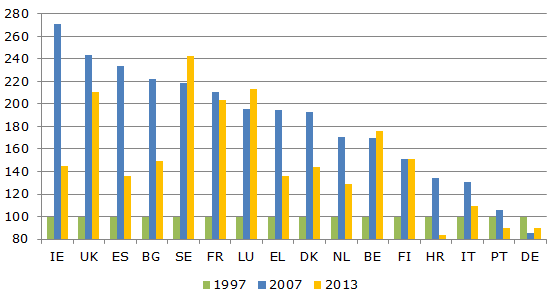

Accessibility tools
Service tools
Language
Navigation path
The European Commission’s Alert Mechanism Report (AMR), to be published later this month, kick starts the EU’s annual Macroeconomic Imbalance Procedure (MIP), an early warning system to detect and address economic trends that could upset the smooth functioning of national economies, the euro area, or the EU.
The AMR provides an objective analysis of EU economies based on a comprehensive economic analysis of a scoreboard of indicators, which include current account balances and house prices.
Current account balance (as % of GDP)

Source: DG ECFIN
In simple terms, a country’s ‘current account balance’ looks at the balance between how much a country sells abroad, its exports, and how much it buys from abroad, its imports.*
If a country imports more than it exports, its current account shows a deficit. If a country exports more than it imports, its current account shows a surplus.
Because they buy more from abroad than they sell, countries with current account deficits have to borrow money or sell assets to pay for the difference. This becomes a problem if deficits grow very large or continue for a long time, as it leads to increasing indebtedness and potentially, financial vulnerability.
Countries with current account surpluses, by contrast, earn more money than they spend. This may sound like a ‘nice situation’ to have but current account surpluses may be less attractive than they appear, if they are caused by spending shortfalls that result from weak domestic demand and investment.
Weak investment is particularly worrying as it could reduce a country’s potential growth in the future. Moreover, if the reason for a surplus is weak investment, it means that the money being generated by the surplus is not being put to work in the domestic economy but is either being lent or invested abroad.
Inflation-adjusted house price index (1997 = 100)

Source: DG ECFIN
House prices are hugely important to most individuals’ personal finances and many banks devote a large proportion of their money to mortgages. Building houses also requires a lot of investment and requires many workers. As a result, house prices have a big impact on the economy.
Rising house prices can be beneficial to an economy because it increases the wealth of homeowners and because it encourages construction, which creates jobs. If the economic situation changes and house prices start to fall, however, many people, banks, companies and workers may suffer.
The European Commission keeps a careful eye on house prices in the MIP to help governments avoid problematic developments in the housing market that could hurt the economy.
* By focusing only on exports minus imports we make a simplification as the trade balance is usually the largest component of the current account balance. On top of trade balance, the current account has two other components: net income from abroad and remittances.
Have a look at the full set of scoreboard indicators:
Find the latest Alert Mechanism Report on our MIP page:
Read more about the economy of your country:
Additional tools